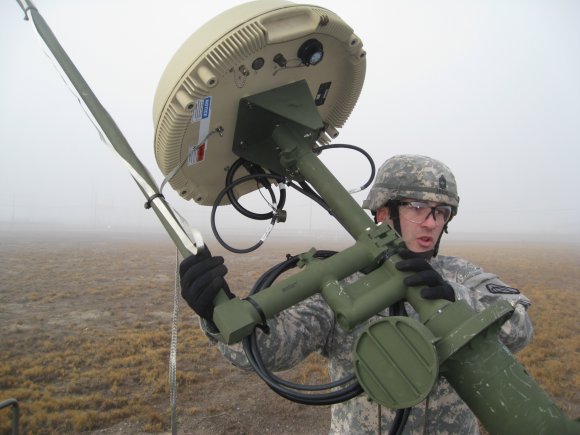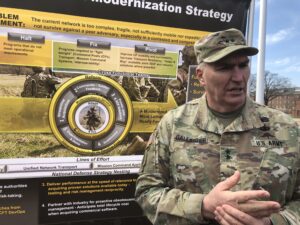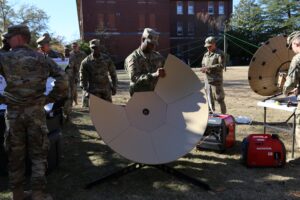
An Army soldier sets up a highband antenna in Afghanistan.
WASHINGTON: “This is definitely improvised mode,” the Army’s network modernization director told me. “A lot of these things that we’re experimenting with out here [in the Yuma Desert] probably had never been connected to anything, outside of a gigabit switch in their labs, up until we did it [for the first time] in June.”
Just three months later, Maj. Gen. Peter Gallagher told me, the ad hoc network created for the Project Convergence exercises is moving more data, faster and further than the equipment was ever designed to do.

Maj. Gen. Peter Gallagher
Information flows from intelligence satellites – none of them operated by the Army – down to Joint Base Lewis McChord in Washington State, which is acting as the equivalent of a theater headquarters for the exercise. Artificial intelligence software there processes the data and transmits vital updates to the frontline combat units at Yuma Proving Ground in Arizona, 1,300 miles south. How fast can this happen? Gallagher’s boss, Army Futures Command chief Gen. John Murray, has boasted that the timeline from a satellite spotting a target to artillery firing on it has dropped from “tens of minutes” in normal operations to “less than 20 seconds” in Project Convergence.
Making that happen, Gallagher and his staff told me, required finding functional surrogates for future systems that don’t exist yet and using available technology in ways its designers never envisioned. “The network underpins every single thing we’re trying to do” in Project Convergence, he said. “We have to be able to use waveforms and technology that works today, not necessarily what we’re going to have.”
Much of the network tech in use for Project Convergence won’t be fielded to regular units until 2021, but small quantities were already ready, or at least ready enough to use. But the 2021 upgrade package, aka Capability Set 21, was designed to improve existing communications among the ground troops within an infantry brigade – not transmit real-time targeting data over hundreds of miles from spy satellites, AI command hubs, or experimental mini-drones.
“We’re pushing them to limits that we never envisioned,” Gallagher told me. “It’s a mesh network solution with some advanced networking waveforms” – primarily TrellisWare’s TSM – “that significantly improves the warfighting capability of our maneuver brigades, but it was not fielded to do the things we’re doing.”
“We’re finding out that it works for many cases, and then it has to be augmented” in others, he said.
Since the CS21 systems are relatively short-ranged, Gallagher’s team are also using some tech that is still in development for the 2023 upgrade. That kit, called Capability Set 23, will upgrade long-range communications using commercial and military satellites in Low-Earth Orbit (LEO) and Medium Earth Orbit (MEO), which fly closer to earth than traditional Geosynchronous Orbit (GEO) birds.
The problem? Very few of those satellites have actually been launched yet.
“For Low Earth Orbit, there’s just not enough satellites in the sky for us to get that kind of coverage,” Gallagher told me. The Army was able to try out a Mid-Earth Orbit link from McCord to Yuma during part of Project Convergence, he said, but the main high-bandwidth backbone for the satellite data is going through GEO.
To get that geosynchronous link to function on the scale required for Project Convergence, the Army deployed assets from a specialized support unit, the 50th Expeditionary Signal Battalion – Enhanced (ESB-E). That “Enhanced” designation means the unit has the latest upgraded communications equipment, stuff that’s not available to the vast majority of Army units.
But even the ESB-Enhanced doesn’t have one crucial link in the space-to-ground communications chain, a ground station the Tactical Intelligence Targeting Access Node, because TITAN is still in development. Instead, the Army is using a surrogate system called ADV, basically a prototype for some of TITAN’s key technologies. The Army’s Intelligence, Surveillance, & Reconnaissance (ISR) Task Force has helped link this proto-TITAN into existing targeting systems like the inter-service JADOCS and Army artillery corps’ AFATDS.
Getting these and other technologies to work together can take a lot of coding and reconfiguration, creating new APIs (Application Programming Interfaces) and software plugins. Gallagher said that a smartphone-based program called the Android Tactical Assault Kit (ATAK)– widely used by frontline units — and its software development toolkit have proven a versatile and invaluable tool.

Soldiers from the 50th Expeditionary Signal Battalion – Enhanced (ESB-E) set up a satellite dish.
It also takes careful coordination to ensure fine-tuning any given system doesn’t create problems for other systems trying to connect to it, especially if they’ve never been connected before. “Scientists and lab rats… they love tinkering with stuff,” Gallagher said, but all too often, “they make a configuration change to solve a local problem, and they don’t realize they created a network-wide issue.
“It’s one thing to kind of shake it out in a big hangar [where] everybody can look each other in the eye,” as the Army did for the first time in June, Gallagher said. It’s another thing to get it all working across the vast Yuma Proving Ground, he said, where “the tyranny of distance in the desert, and the tyranny of heat, has an impact on both people and equipment.”
Even something as seemingly trivial as connecting to the wrong port can create wider problems, Gallagher said. And then there are the much bigger questions that the Army cannot answer yet, because the whole point of Project Convergence is to figure them out. How much data, about what, does any given commander really need to make the right call in combat? What data do some units need but not others? What unneeded information is just cluttering up the network?
“What we’re capturing here…is going to drive our design goals” for future systems,” Gallagher said. “It’s been a great forcing function to get all the labs working together.”
“It’s been painful,” the general said bluntly. “Some days have been better than others — [but] I couldn’t be more proud of my team.”























